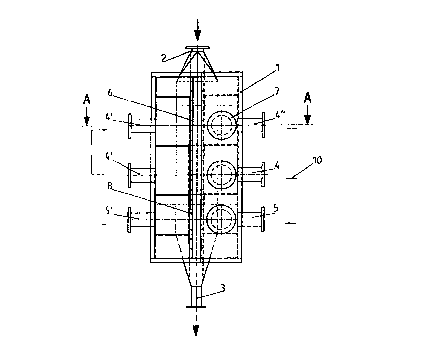Some of the information on this Web page has been provided by external sources. The Government of Canada is not responsible for the accuracy, reliability or currency of the information supplied by external sources. Users wishing to rely upon this information should consult directly with the source of the information. Content provided by external sources is not subject to official languages, privacy and accessibility requirements.
Any discrepancies in the text and image of the Claims and Abstract are due to differing posting times. Text of the Claims and Abstract are posted:
| (12) Patent Application: | (11) CA 2307043 |
|---|---|
| (54) English Title: | DRIER-HEAT-EXCHANGER |
| (54) French Title: | ECHANGEUR THERMIQUE-SECHOIR |
| Status: | Deemed Abandoned and Beyond the Period of Reinstatement - Pending Response to Notice of Disregarded Communication |
| (51) International Patent Classification (IPC): |
|
|---|---|
| (72) Inventors : |
|
| (73) Owners : |
|
| (71) Applicants : |
|
| (74) Agent: | SMART & BIGGAR LP |
| (74) Associate agent: | |
| (45) Issued: | |
| (86) PCT Filing Date: | 1998-08-20 |
| (87) Open to Public Inspection: | 1999-04-15 |
| Examination requested: | 2003-05-28 |
| Availability of licence: | N/A |
| Dedicated to the Public: | N/A |
| (25) Language of filing: | English |
| Patent Cooperation Treaty (PCT): | Yes |
|---|---|
| (86) PCT Filing Number: | PCT/CH1998/000353 |
| (87) International Publication Number: | WO 1999018404 |
| (85) National Entry: | 2000-03-30 |
| (30) Application Priority Data: | ||||||
|---|---|---|---|---|---|---|
|
The invention relates to a drier-heat-exchanger for heat-treating PET
granulate and similar. Instead of the usual shaft covering the whole cross-
section, the inventive drier only has a channel which is delimited by air-
permeable sheets (6). This ensures that the product can pass through
efficiently and evenly which in turn means that a higher gas speed can be used
without the product being stirred up and therefore that shorter heating times
are possible.
L'invention concerne un échangeur thermique-séchoir pour le traitement thermique de granulés de PET et analogue. Le séchoir comporte, à la place de la cuve habituelle, uniquement un canal sur toute la section transversale, lequel est délimité par des tôles (6) perméables à l'air pour permettre une ventilation satisfaisante et homogène du produit, ce qui autorise une vitesse élevée du gaz sans soulèvement turbulent du produit, et ainsi des temps de chauffage courts.
Note: Claims are shown in the official language in which they were submitted.
Note: Descriptions are shown in the official language in which they were submitted.

2024-08-01:As part of the Next Generation Patents (NGP) transition, the Canadian Patents Database (CPD) now contains a more detailed Event History, which replicates the Event Log of our new back-office solution.
Please note that "Inactive:" events refers to events no longer in use in our new back-office solution.
For a clearer understanding of the status of the application/patent presented on this page, the site Disclaimer , as well as the definitions for Patent , Event History , Maintenance Fee and Payment History should be consulted.
| Description | Date |
|---|---|
| Time Limit for Reversal Expired | 2008-08-20 |
| Application Not Reinstated by Deadline | 2008-08-20 |
| Inactive: Abandoned - No reply to s.30(2) Rules requisition | 2007-09-05 |
| Deemed Abandoned - Failure to Respond to Maintenance Fee Notice | 2007-08-20 |
| Inactive: S.30(2) Rules - Examiner requisition | 2007-03-05 |
| Inactive: IPC from MCD | 2006-03-12 |
| Amendment Received - Voluntary Amendment | 2005-09-26 |
| Inactive: S.30(2) Rules - Examiner requisition | 2005-09-06 |
| Amendment Received - Voluntary Amendment | 2003-07-07 |
| Letter Sent | 2003-06-18 |
| Request for Examination Requirements Determined Compliant | 2003-05-28 |
| Request for Examination Received | 2003-05-28 |
| All Requirements for Examination Determined Compliant | 2003-05-28 |
| Letter Sent | 2000-07-20 |
| Inactive: Cover page published | 2000-06-23 |
| Inactive: Single transfer | 2000-06-20 |
| Inactive: First IPC assigned | 2000-06-15 |
| Inactive: Courtesy letter - Evidence | 2000-06-13 |
| Inactive: Notice - National entry - No RFE | 2000-06-08 |
| Application Received - PCT | 2000-06-05 |
| Application Published (Open to Public Inspection) | 1999-04-15 |
| Abandonment Date | Reason | Reinstatement Date |
|---|---|---|
| 2007-08-20 |
The last payment was received on 2006-07-20
Note : If the full payment has not been received on or before the date indicated, a further fee may be required which may be one of the following
Please refer to the CIPO Patent Fees web page to see all current fee amounts.
| Fee Type | Anniversary Year | Due Date | Paid Date |
|---|---|---|---|
| MF (application, 2nd anniv.) - standard | 02 | 2000-08-21 | 2000-03-30 |
| Basic national fee - standard | 2000-03-30 | ||
| Registration of a document | 2000-06-20 | ||
| MF (application, 3rd anniv.) - standard | 03 | 2001-08-20 | 2001-08-10 |
| MF (application, 4th anniv.) - standard | 04 | 2002-08-20 | 2002-07-15 |
| Request for examination - standard | 2003-05-28 | ||
| MF (application, 5th anniv.) - standard | 05 | 2003-08-20 | 2003-07-16 |
| MF (application, 6th anniv.) - standard | 06 | 2004-08-20 | 2004-07-20 |
| MF (application, 7th anniv.) - standard | 07 | 2005-08-22 | 2005-07-21 |
| MF (application, 8th anniv.) - standard | 08 | 2006-08-21 | 2006-07-20 |
Note: Records showing the ownership history in alphabetical order.
| Current Owners on Record |
|---|
| BUHLER AG |
| Past Owners on Record |
|---|
| FILIPPO TERRASI |
| HANS GEISSBUEHLER |